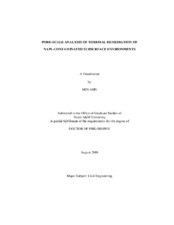| dc.description.abstract | The possible benefits of thermal remediation of NAPL-contaminated subsurface
were analyzed at pore-scale. Force balance analysis was performed to provide the insight
and information on the critical conditions for the blob mobilization. First, the critical
blob radius for blob mobilization was calculated in terms of blob radius, temperature,
and water velocity. Temperature increase enhanced the blob mobilization along with the
decrease of interfacial tension. Water velocity increase also enhanced the blob
mobilization. Critical water velocity provided the critical condition for the initiation of
blob mobilization to distinguish singlet and doublet in blob size.
Second, the terminal (or steady state) blob velocity at the steady state blob motion
was determined. Increases of temperature and water velocity raised the terminal blob
velocity. When the observation of blob mobilization moved from REV scale (macroscale)
to pore-scale, terminal blob velocity showed the different phenomena according to
the change of oil saturation. At macro-scale, the terminal blob velocity was smaller than water velocity by an order or two. However, the terminal blob velocity reached to water
velocity at pore-scale.
This investigation would provide the better understanding on the pore-scale analysis
of residual NAPL blob mobilization by thermal remediation. Additionally, the pore-scale
analysis developed in this study would be incorporated into a general conservation
equation in terms of the accumulation of multiple blobs. It would derive continuumaveraged
equations that accurately represent pore-level physics. In conclusion, the study
on the critical conditions for the initiation of blob mobilization as a single discrete blob
would have some contribution to the transport and fate of NAPL contaminant and the
desired subsurface remediation. | en |


